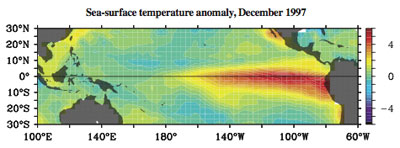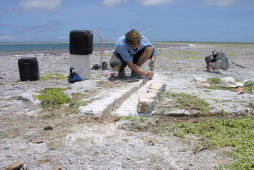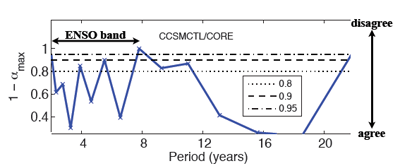 |
|
A winning proposal for the Innovative Research Program, 2010: Statistics of ENSO past and present: Comparing climate models to coral reconstructionsInvestigators:Baylor Fox-Kemper (CIRES), Samantha Stevenson (University of Wollongong), Helen McGregor (University of Wollongong), Steven Phipps (University of New South Wales) Objectives
New wavelet-based statistical tools will be used to validate coupled climate models against coral reconstructions of the El Niño/Southern Oscillation (ENSO) over the past few thousand years. These novel statistical techniques, developed at CIRES, have shown promise in validating climate models against modern observations, but the short duration of observations has limited the power of the method. Taking advantage of an opportunity for synergistic collaboration with Australian scientists, we will perform the first statistically robust diagnosis of ENSO model/data agreement on millennial timescales. The project has potential for leaps in understanding coupled climate model performance and ENSO response to climate forcing, and it will initiate new international and interdisciplinary collaborations. Background and ImportancePaleoclimate data provides context for modern observations, which is sorely needed when studying the decadal-to-centennial variability of interannual climate signals like the El Niño/Southern Oscillation (ENSO). How representative is the 25 year TAO/TRITON ENSO record? How unlikely was the strongest observed El Niño event (1997-8; Fig 1a, NOAA estimates $25 billion damage) when compared to the past 5,000 years (e.g., coral reconstructions in Fig. 1b)? How much has ENSO variability changed in the past, and how much is it likely to change in the future? How reliably can we estimate these changes over long timescales, when anthropogenic climate change is expected to have a profound impact? ENSO strongly influences drought and flooding events in both Australia and the US (Ropelewski and Halpert, 1987), thus planners in both regions require good ENSO statistics over decadal and longer timescales. Under likely future forcing and past orbital forcing (e.g., the Maunder minimum) ENSO activity is expected to change, but the direction of projected change is not consistent among models (Guilyardi et al., 2009), and may not necessarily dominate over natural decadal variability (Power et al., 1999). Coupled climate models are calibrated against and generally perform well when simulating modern observations (Neale et al., 2008), but variations on centennial timescales (Wittenberg, 2009; Stevenson et al., 2010) indicate that models are likely ‘overtuned’ to our short instrumental record, hindering simulations of past and future climates. Innovative AspectsWe propose the first quantitative validation of the (Boulder) NCAR CCSM and (Australian) CSIRO Mark 3L against both modern observations and coral paleorecords (McGregor and Gagan, 2003) simultaneously. Validation will rely on the recently developed wavelet probability analysis (WPA) toolbox of Stevenson et al. (2010)1, which uses the probability distribution function of the wavelet spectrum to measure spectral variability. By comparing subsets of one time series to subsets of another, it is possible to determine at any desired confidence level whether the two time series differ (see Figure 2). Wavelet techniques naturally allow simultaneous treatment of gappy timeseries (e.g., coral paleorecords) with continuous, though limited-duration, modern observations, but WPA has only been used for model validation against modern observations. This innovative research project will demonstrate WPA’s utility for paleoclimate. Serendipitously, Drs. Helen McGregor at the University of Wollongong (UOW) and Steven Phipps at the University of New South Wales (UNSW) have a new data/model comparison project, which seeks to understand the contribution of climate change to the ENSO record using both fossil coral records and (CSIRO Mk3L) model integrations. Coral records (McGregor and Gagan, 2003) from several locations in the western and central Pacific and millennial CSIRO Mk3L simulations are therefore available, but no robust statistical techniques for model/data comparison have yet been developed or used by the Australian group. As such, the Australian and Boulder teams are complementary. The collaboration will demonstrate CIRES-developed model validation tools as well as broaden and further the CIRES presence in paleoclimate and climate diagnosis research. 1http://atoc.colorado.edu/~slsteven/wpi/ Research PlanMs. Stevenson will be traveling and working on this project as part of her PhD thesis (which has already resulted in the development of the WPA tools). Comparison of the CSIRO Mk3L vs. NCAR CCSM and modern observations will be performed in Boulder this summer, followed by a visit to UOW and UNSW during the 2010/11 academic year. The research plan is:
Methods for collecting and processing the coral records are described in (Gagan et al., 1998; McGregor and Gagan, 2003). In the McGregor lab there are a variety of corals available for analysis, having been collected from several locations in the western Pacific: from Papua New Guinea at both Muschu and Rambutso islands (3?S, 143?E and 1?S, 147?E respectively). Central Pacific coral records are available as well, from Kiritimati (1?N, 157?W). The record from Kiritimati in particular has been shown to exhibit an extremely strong correlation between the d18O record and SST, making this an ideal candidate for use in data/model comparisons.
Separating the effects of sea surface temperature and salinity (SST/SSS) signal on the coral d18O will be achieved using the methods of Brown et al. (2008) to create ‘pseudocoral’ records from the CSIRO Mk3L integrations. The pseudocoral method makes use of observed relationships between sea surface temperature and salinity and the oxygen isotopic ratio at a particular location, to derive the expected d18O for the model output given its SSS and SST. This method has proven relatively accurate in the past (Brown et al., 2008), and in the absence of detailed isotopic simulations is probably the most reliable method available. Dr. McGregor is experienced in this analysis, and being able to rely on her expertise should be most valuable for this part of the project, which will occupy roughly the first two weeks. Results will include a proof-of-concept demonstration of WPA use with paleodata, a comparison of CCSM and CSIRO Mk3L with coral variability throughout the Holocene era, and clues as to the physics and model parameters that drive and control ENSO variability on centennial and longer timescales. Expected Outcome and ImpactOur innovative, robust statistical methods will compare long model integrations and high-resolution coral proxy data to understand long-term variations in ENSO activity. The project timing takes advantage of the recent completion of the WPA toolkit and the start of the McGregor/Phipps project to create a new model validation paradigm. Our results will be useful for modern and paleoclimate work: we will provide statistical evaluation of climate models relative to both ancient and modern observations, yielding the first statistically robust, millennial-scale climate model validation. The work will serve as proof of concept for more detailed model/data comparison of ENSO using paleoclimate records. References
|


 Figure 2: Minimum significance level 1 − α at which a model and modern ocean data disagree. Disagreement at 8yr and > 20yr may be observational undersampling or model bias.
Figure 2: Minimum significance level 1 − α at which a model and modern ocean data disagree. Disagreement at 8yr and > 20yr may be observational undersampling or model bias.